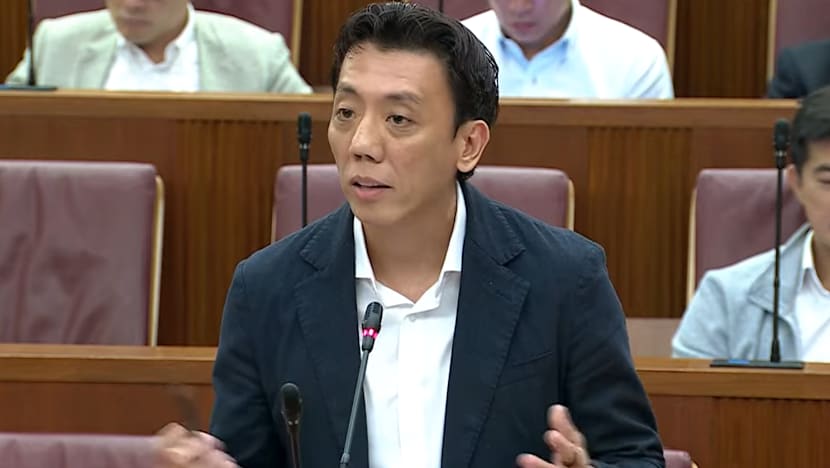Acting transport minister pledges more precise information during MRT incidents; says 'zero disruptions' unrealistic
Mr Jeffrey Siow’s comments come on the heels of public transport operator SMRT’s assurance that the string of recent rail disruptions this month were isolated cases and not systemic.

Acting Minister for Transport Jeffrey Siow speaking in parliament on Sep 22, 2025.

This audio is generated by an AI tool.
SINGAPORE: Commuters should have more precise information during an MRT breakdown, Acting Minister for Transport Jeffrey Siow said in parliament on Monday (Sep 22), as he sought to address growing concerns over recent train disruptions.
Speaking in response to 18 parliamentary questions filed on rail reliability, Mr Siow acknowledged the public frustration following a series of disruptions.
Four train disruptions on the SMRT-operated North-South Line, East-West Line, Thomson-East Coast Line and the SBS Transit-operated Punggol LRT had happened in the span of five days this month.
Still, Mr Siow cautioned that “zero disruptions” is an unrealistic expectation.
“Train delays happen in every system, in every city. Our phones, our computers have to be restarted every now and then. Cars will break down too. So will our trains,” he added.
Despite the inevitability of disruptions, the goal is still to “absolutely minimise” them due to the inconvenience to commuters, and the authorities will “work doubly hard to do so”.
“What is equally important is when a disruption inevitably happens, we can support commuters, and guide them to continuing their journeys safely, with their understanding and cooperation.”
Mr Siow’s comments come on the heels of public transport operator SMRT’s assurance that the string of recent rail disruptions this month were isolated cases and not systemic.
The Land Transport Authority's (LTA) figures released on Sep 5 showed that overall MRT reliability from July 2024 to June 2025 dropped to its lowest level in five years.
Mr Siow said that every single rail incident is taken seriously.
“I am personally alerted whenever there is a train incident, even when it is late into the night or during engineering hours,” he said. “We want to be accountable to commuters.”
Mr Siow added that he has also asked the LTA to share more data on train disruptions publicly.
“We will be transparent, because we have a good system, and we have nothing to hide,” he said.
SHOULD SINGAPORE RETHINK RAIL RELIABILITY METRIC?
Among the questions filed, Mr Sharael Taha (PAP-Pasir Ris-Changi) asked how Singapore’s rail reliability targets compare with other rail networks in other countries.
Mr Siow said that using the reliability indicators such as the mean kilometres between failure (MKBF), Singapore’s train system remains one of the most reliable in the world.
Singapore's MKBF for the 12-month period leading up to August 2025 is about 1.7 million train-km. This is higher than the 1 million target that had been set in 2017, but lower than the peak MKBF of over 2 million in 2022 and 2023.
The figure is also higher than Hong Kong MTR’s, though lower than Taipei Metro’s, and for the number of service delays exceeding 30 minutes per million train-km, the MRT performs about the same as metros in Tokyo and other Japanese cities, noted Mr Siow.
“I have asked LTA to publish these comparisons regularly, because Singaporeans often compare our MRT to these systems,” he said.
Mr Sharael also asked if the Ministry of Transport would consider increasing the MKBF target to above 1 million MKBF and introducing a yearly improvement target.
Mr Siow said that beyond 1 million train-km, variations in the MKBF are less meaningful, especially when the number of disruptions per year is very small.
For example, the MKBF of the Downtown Line was 8 million train-km in 2023 and 2024, but one additional delay had halved it to 4 million.
Another drawback of the MKBF is that it does not measure the length of the disruption, and hence the impact on the commuter.
“For example, a complete service stoppage is treated the same as more frequent minor incidents, even when trains are moving and passengers are able to carry on with their journeys,” said Mr Siow.
Alternatively, consumer impact is considered by LTA, which then imposes financial penalties on operators for serious disruptions.
Responding to a question by Mr Louis Chua (WP-Sengkang) on financial penalties imposed on train operators, Mr Siow said that LTA has imposed an average of around four such penalties per year on operators in recent years.
COMMUTERS SHOULD HAVE MORE PRECISE INFORMATION DURING BREAKDOWNS
A Rail Reliability Taskforce was announced by Mr Siow earlier this month to “take a harder look to satisfy ourselves that there is no systemic problem” when it comes to train disruptions.
The task force will look into bringing forward the renewal of critical systems such as power supply and signalling, and jointly conduct audits on the maintenance and operations of critical systems, said Mr Siow.
It will also look into reviewing the service recovery process wherever there is a breakdown.
The train operators have been informing commuters of service delays in excess of ten minutes, as required by the LTA, and while this is a basic requirement, more can be done, he said.
For instance, commuters should have more precise information on alternate travel routes and additional travel time, depending on their specific location rather than generic advisories, said Mr Siow.
There should also be centralised information on a single app, so commuters know “exactly where to look during a disruption”, and directional signs can also be improved.
“The recent disruptions have inconvenienced many commuters,” said Mr Siow.
“I understand the frustrations, and I want to assure commuters that we are doing our best to improve our performance.”
Ms Tin Pei Ling (PAP-Marine Parade-Braddell Heights) asked a supplementary question on how rail performance will continue to be reliable going forward, given the spate of recent incidents.
Mr Siow said that the number of rail disruptions so far this year was about the same as that of the same period last year.
He asked: "Why is it that there was so much attention this year?"
"My hypothesis, which I think is probably likely, is that the impact of the individual disruptions were far greater than the ones that happened last year," he said.
He added that the rail network is in the process of being doubled over the next 10 years, and as such, if the number of train disruptions is not doubled, "our rail reliability would have improved".
"That is not to say we will not put in effort to minimise the number of train disruptions. We will, and we will put in our effort ... But this is mathematics, this is reality," he said.
















